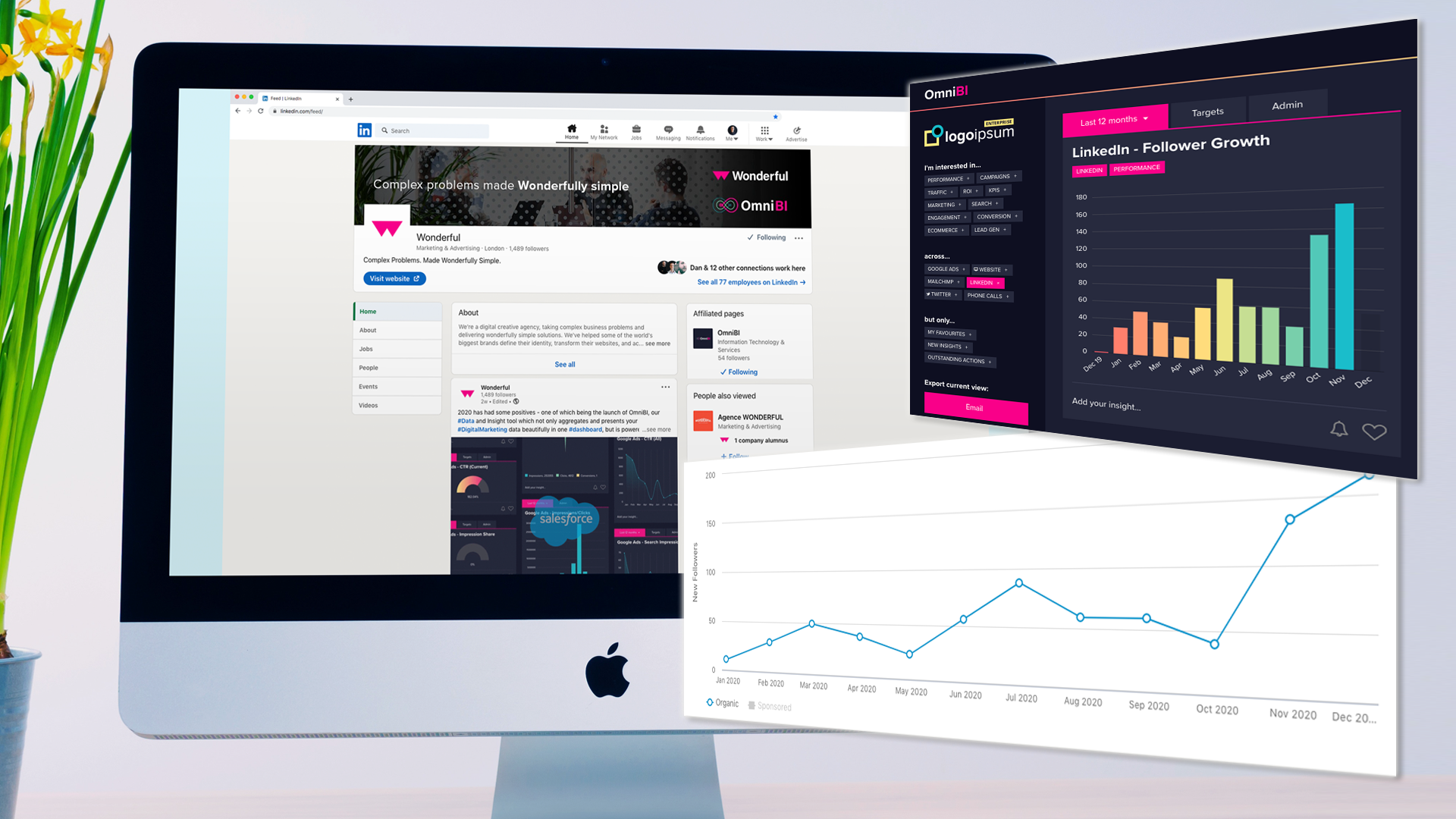
LinkedIn, like many other social networks and online connectivity products, thrived in 2020. As businesses were forced to accelerate digital adoption (some say by more than 5 times faster than previously estimated), so were their employees. LinkedIn became the professional B2B social network of choice, reviving it’s usage as an online venue to replicate face-to-face networking, despite social distancing and travel restrictions imposed as a result of the Coronavirus pandemic.
We love data at Wonderful, and the numbers don’t lie. In September 2020, SimilarWeb reported LinkedIn traffic of 1,117 million. This marked five months of consistent traffic growth since April when the pandemic’s impact was fully being felt under the effects of remote working and rapid digitisation. This made LinkedIn the 24th most visited site globally.
LinkedIn Traffic (Millions) Apr-Sept 2020 (Source: Statista)
When you dig into the numbers, it starts to be made clear just how important (and potentially lucrative) it could be to leverage this platform.
LinkedIn in Numbers
With 2020 being such a huge year for adoption of platforms like LinkedIn, it’s unlikely that this needs explaining to many of you, but here’s some interesting numbers to emphasise the reach of the platform:
- LinkedIn is available in 200 countries (LinkedIn)
- LinkedIn is ranked 24 globally for traffic, and 57 globally for engagement August-October (Alexa)
- Over 50 million companies have profiles on LinkedIn (LinkedIn)
- In 2019, 90 million LinkedIn users were senior-level influencers & 63 million were in decision-making positions (LinkedIn)
- 46 million student & 87 million Millennial LinkedIn users (11 million of whom are decision makers) in 2016 (LinkedIn)
- Median number of connections between 500 and 999 (Statista)
- 57% of LinkedIn traffic comes from mobile devices (VentureBeat)
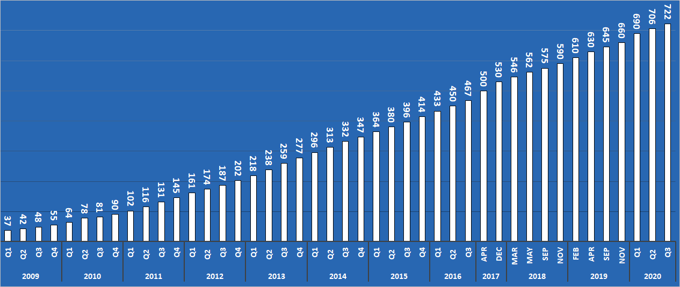
LinkedIn User Growth (Millions) 2009 – 2020 (Source: Statista/Microsoft)
- 9 billion content impressions took place on LinkedIn weekly in 2017 (LinkedIn)
- 280 billion feed updates viewed annually (LinkedIn)
- 437% year-on-year increase in LinkedIn Live streams views reported in October 2020 (LinkedIn)
- 1 million hours of LinkedIn Learning content watched per week (LinkedIn)
- 130,000 articles are published on LinkedIn weekly (LinkedIn via Search Engine Journal)
- 80% of B2B leads come through LinkedIn (LinkedIn)
- LinkedIn purchased by Microsoft in Dec 2016 for $26.2 billion (Microsoft)
- LinkedIn revenue for Q1 2021 came to $1.86 billion (Microsoft)
- Only 1% of users post content weekly as of 2017, though 91% of marketing executives use LinkedIn as a content source (LinkedIn)
It’s the last statistic in that list we want to focus on here, because it will go a long way to explaining why you, or your business, might be experiencing relatively low engagement and organic performance.
Organic Reach – Free Advertising!
2020 saw Wonderful run a number of highly successful LinkedIn Advertising Campaigns, as clients such as Expand Research (A BCG Group Company) and CSI Leasing looked to leverage the increase in usage to aid in replacing real-world networking & advertising opportunities like conferences and events.
However, since the inception of businesses using Social Media, it has been seen as a huge opportunity to generate ROI through utilising the Organic Reach potential – every post, update, tweet, article, photo, video, link can be seen with (almost*) zero cost to your business, leading to awareness, a click, an engagement, a visit to your website, a contact form fill, a phone call, a lead submission, a sale…
(*Ok, there is a talent & time-cost associated with managing social channels, we get this, and to do it properly, you probably want to employ a specialist digital agency).
It is evident there’s a big opportunity in generating ongoing engagement with the right audience on LinkedIn – but if you’re going to go on this journey, it’s important that it is done so strategically and that you set aside the relevant amount of resource to achieve results. Even LinkedIn wrote about this themselves when they grew their own LinkedIn Marketing Solutions profile to 1 millions followers.
Generating wins from the platform requires consistency over the long term (as with most social media platforms). We can’t promise the following tips will make you an instant overnight LinkedIn superstar, but your efforts can drive years of ROI for your business in the longer term. Let’s begin.
Here’s 10 tips to Grow Organically on LinkedIn:
- Set Engagement Targets (Not Vanity Metrics)
- Deliver Value To Your Audience
- Maintain The Pace
- Stop The Scroll, Grab Attention & Catch The Eye
- Mix & Blend
- Comment On Comments
- Utilise #Hashtags
- Create A Call To Action
- Encourage Advocacy
- Monitor, Measure & Improve
1. Set Engagement Targets (Say No To Vanity Metrics)
We’ve written before about Vanity Metrics, and why they can be pretty meaningless when it comes to winning in digital marketing and measuring your business success. That being said, typical vanity metrics such as follower numbers aren’t for vanity if you use them, and if they can lead to a true measurable impact on your business – Follower Numbers, a typical example of this, can benefit you on LinkedIn, as the algorithm will show content to followers and typically 1st Level connections as a priority.
However, the key metrics to consider here are engagement. Just following your page and potentially seeing your content in the feed isn’t enough to demonstrate any sort of easily measurable ROI. You should set an engagement goal based on actions which lead to the next desired action, and track this over time.
Metrics to measure against might include: Post Engagements (likes, comments, shares); and Clicks through to your website. Many brands will look at this in a ratio format, with a metric such as CTR (click through rate), demonstrating that your post has encouraged click-through to your website or other content as the user has intent to learn more or commit to enquire. Treating this as a percentage or ratio is particularly important, as a proportionally higher number of clicks versus the number of times the post was seen (impressions) demonstrates the content is doing a better job of prompting the desired behaviour.
2. Deliver value to your audience
This can’t be overstated enough. There is a myriad of “LinkedIn Guru” posts purporting to there being mystical and magical ways to generate better returns on LinkedIn, but realistically, these largely boil down to serving the most relevant content to the most relevant audience which, most importantly, actually delivers value to the audience.
As LinkedIn put it: “A successful content strategy requires an exchange of valuable content for audience engagement. Simply put, if you want and expect LinkedIn members to engage, you need to add value by providing helpful, inspiring content. Do this by staying hyper-focused on what matters most to your audience.”
Think outside of ‘me, me, me’. It is very easy to slip into the habit of telling people what you do and how you do it all the time, but this often delivers little tangible value to your audience, or potential customers. Try and share examples of problems your audience might be experiencing and how to remedy them, share content from your website that is genuinely interesting and engaging for your next potential lead, bring something new to the table – it can even be entertaining, rather than just helpful/educational. Research, infographics, reports, white-papers, video posts and even a funny gif can all deliver value in their own way, so use the right media strategically to meet this need.
As long as it brings value, it will enhance your positioning with your audience and help nurture followers to take that next engagement action.
3. Maintain the pace
Often referred to as cadence or velocity, the combination of the number of posts and how often you are posting from your channels can have a huge impact on organic growth. LinkedIn themselves state that you gain “meaningful, consistent engagement and foster familiarity by posting via your LinkedIn Page at least once per day”. Most businesses will see the highest engagement when posting in the morning — with a slight resurgence in engagement again after business hours. The key is to experiment to see what works best for your business in your industry, as every audience will be different, ranging from the times they consume content to the medium they are served at that time.
LinkedIn Advertising Campaigns are engineered to hit the targeted audience at the right time to generate engagements and clicks which, ultimately, are where any CPC (cost per click) advertising platform earn their income. You can operate with a similar mindset in terms of timing of your posts. Look to share posts when your audience is most active and engaged. This chart from Sprout Social may be a helpful place to start, but as your audience grows, be sure to look at when your followers are actually engaging most with your brand.
LinkedIn Global Engagement Heatmap 2020 (Source: Sprout Social)
4. Stop the scroll!
Stopping the scroll, grabbing attention and catching the eye are all vital if you’re going to start to capture your audience’s attention organically. Famously in recent years, Video has been crowned the undeniable king of content on the platform, but this is becoming less unilaterally true as different audiences demonstrate a desire to consume the right mix / variety of content before engaging or following you organically.
The truth still remains that rather than just posting text-based updates on your Company LinkedIn Page, choosing a variety of rich media formats such as videos can help take your page from static to dynamic and make your post stand out (posting native videos with captions on your LinkedIn Page has proven popular in 2020). Videos and images grab attention and will boost the chances of broadening your reach: According to LinkedIn’s own research, members are 20x more likely to share a video on LinkedIn than any other type of post.
However, did you know there are some pretty interesting and engaging formats which other social networks don’t utilise quite as much? We have found some excellent organic post engagement comes from posting Microsoft Word documents, PDFs and PowerPoints (sometimes presented in a ‘Slideshare’ format).
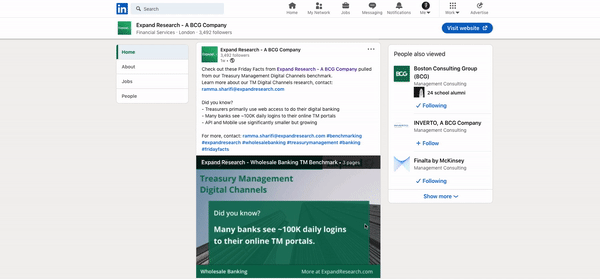
Interestingly, numbers show that pandemic conditions may have contributed to an increase of the use of LinkedIn as a audio-visual platform. In October 2020, LinkedIn reported a 437% year-on-year increase in livestreams. 1 million hours of LinkedIn Learning are also reportedly watched per week – a reflection of the re/up-skilling revolution prompted by coronavirus. Something to bear in mind when planning your content mix.
5. Mix and blend
LinkedIn suggests using what is known as the “4-1-1 rule” guide your content shares. This means that for every content asset you share about your own brand, you should share an update from another source, and up to four pieces of content published by others. The theory behind this echos the previous point about not being solely focussed on your business all of the time, moreover focussing on your audience’s needs and the wider context of why they may choose to engage with you. Stay valuable and stay relevant.
The temptation is to feel the need to create new, rich content every day, but with this mix and blend of content, you don’t need to create new content from scratch every day. Instead, repurposing infographics, blog and news articles, videos and webinars can help share your brand story. You should also ensure re-share your top-performing content so anyone who missed it the first time gets another shot at seeing it.
6. Comments on comments
LinkedIn is, at its heart, a social network, connecting real people to real people digitally. So, it is vital to honour the “social” part, by interacting with other users and encouraging your audience to interact with you. This is one of the most vital ways of building engagement and community.
Some ways to encourage this two-way behaviour include asking questions and responding to comments on posts (not necessarily just your owned media), with a goal of truly engaging in a two-way conversation rather than monopolising an interaction to get your message across.
Within your company’s social media guidelines, look for every opportunity to come across as personable, warm, friendly and… well…human! Whether referring to the person by name or adding emojis or GIFs to your comments, this is an easy way to connect with your audience and drive valuable engagement, as well as building trust in your brand.
7. Utilise #Hashtags
Hashtags are not only reserved for Twitter and Instagram, they’re equally important on other platforms too and help people find topics and content of interest. On LinkedIn, hashtags are searchable and clickable, meaning your potential audience may well search and can click on hashtag links to find content relevant to them.
Using hashtags in your posts helps users discover and join relevant conversations, and helps you appear in trending conversations, increasing your organic visibility far beyond 1st level connections and followers. To maximise this effect, you can target each LinkedIn Page update to the most relevant audience by featuring the most relevant hashtags to your target users.
In addition to this, many brands choose to utilise the ‘@’ tag to mention users in an update or in the content you’re sharing to leverage their network to gain exposure. This is a tactic to be used sparingly, carefully and only when relevant, but it can really pay off.
8. Create A Call To Action
You aren’t embarking on a LinkedIn strategy (or reading this article) without desired action from users seeing your content. Growing your organic reach increases visibility, and producing the right content will drive engagement, but only if you signpost the next desired user behaviour. Once you’ve captured your audience’s attention, it is absolutely vital to make the most of that opportunity. Whether your goal is to generate downloads, leads, or revenue, encourage your engaged audience to do something by including a timely and relevant Call To Action.
Posts with links can see up to a 45% higher follower engagement than updates without links – it is important to keep these varied and fresh, as well as relevant for the post. Don’t just ask users to ‘read more’ all the time, encourage other actions like: ‘Get In Touch’, ‘Sign Up Today’, ‘Register Now’ or even, ‘Get A Quote’ based on where the user is likely to be in their buying journey with you when they see the post.
9. Encourage Advocacy
This starts with your own team – take advantage of the network effect of ’employee advocacy’ to amplify your reach to further grow and activate your community. According to LinkedIn: “On average, employees have 10x the connections as their company has followers on LinkedIn. When your colleagues share your content with their connections, your brand quickly gains more visibility.” So, encouraging internal advocacy is rather a no-brainer.
However, to really maximise reach, utilise some of the aforementioned tactics on content engagement with users to build relationships & trust to the point where leads and existing customers can vouch for your expertise, sharing your content and bringing you into conversations where your business’ skills, services and products may be needed. Word of mouth and social proof are still some of the most impactful mechanisms in marketing, and this can be leveraged as we move ever-more into the digital space through encouraging this level of advocacy.
10. Monitor, Measure & Improve
This wouldn’t be a Wonderful article if we didn’t highlight the absolutely fundamental need to measure and improve on any digital activity. Businesses are required now to become more data-driven and thankfully platforms like LinkedIn enable this. LinkedIn’s analytics platform is fairly robust for both organic and paid activity, and integrates with our proprietary data and insight tool OmniBI, enabling you to see what is working (and to do less of what isn’t).
Whether using the in-built analytics dashboard, or OmniBI, you can see which organic content is performing best and why, enabling you to optimise your posting cadence, media mix, and CTAs to drive optimal performance. LinkedIn returns data on monthly engagement metrics for all your posts, while also showing Updates, Reach and Engagement separately. Paid activity enables you to drill down even further.
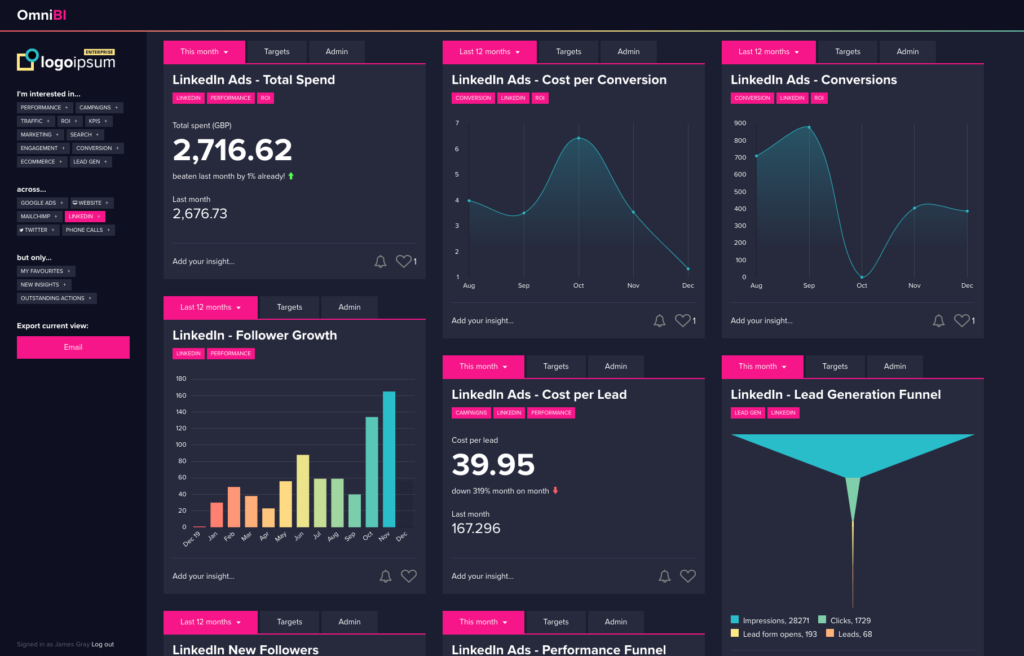
Simply put, you can make use of LinkedIn analytics in a range of ways:
- By analysing who is engaging with what, you can refine your most compelling content formats and offer more of the same
- You can measure each post’s popularity and level of interaction – and determine what content to feature next
- If you add the relevant tracking code to the links in your posts, you can see what traffic you are driving to your company’s site through your LinkedIn Page updates, and adapt accordingly.
As you optimise your posts based on performance, brands can expect to see an increase in overall engagement month over month which will drive organic follower acquisition, grow reach and generate an improved ROI.
Want help with LinkedIn?
This is a top-level summary of the top 10 tips for powering your organic performance on LinkedIn. There are more in-depth areas to explore within any digital strategy, and there is no ‘one-size fits-all’ model for achieving success. Every business has an array of complex challenges, within which LinkedIn may form part of a wonderfully simple solution.
If this sounds like something you may want to explore in greater detail with one of our experts, do not hesitate to get in touch.
Latest posts
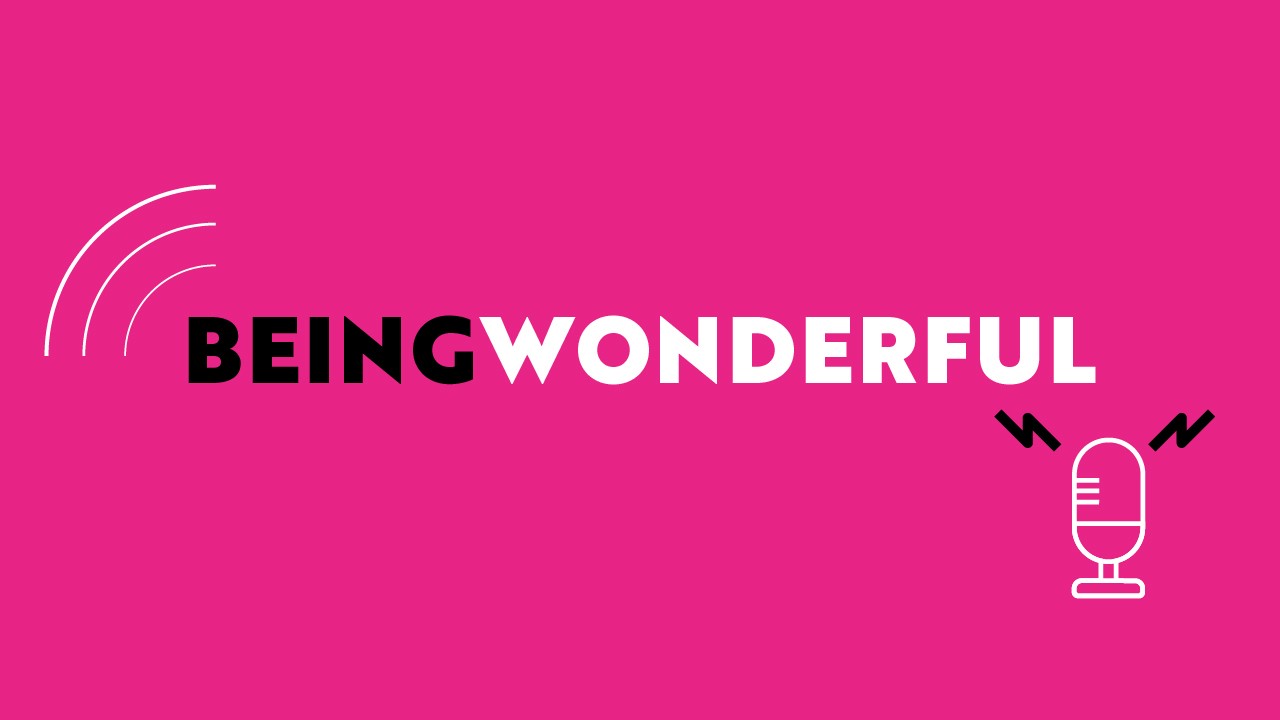
5 reasons why we still need Wonder in an AI driven world
As an agency, we are grappling with the role and application of AI within our daily business activities, our client offering, and our future growth

The Power of Purpose and Impact on Business Growth
In a marketplace increasingly driven by values and social consciousness, the role of purpose and impact in business growth has never been more critical.

Three key benefits of integrating a sense of Wonder within your brand & marketing strategies
We love creating Wonder. It’s our passion and forms our client mission. However, in an age where your customers and clients are bombarded with constant information and countless choices, capturing attention and building lasting connections has become increasingly challenging. We all have to work harder to capture people’s attention.